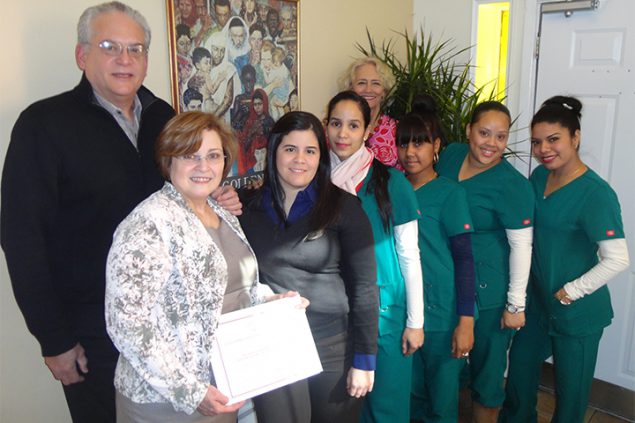Success Story: Family Practice Committed to Communicating with Patients
Broadway Internal Medicine, Queens, New York (2013)
In previous rounds of the Hypertension Control Challenge, Million Hearts® established a benchmark of 70% hypertension control for applicants’ adult populations. This 2013 success story reflects the earlier benchmark.
Broadway Internal Medicine physicians Carlos Gonzalez, MD, and Luz Ares, MD, founded their Queens-based family practice with the vision to make real change within their community, especially among Spanish-speaking residents, with whom the couple—originally from Puerto Rico—shares a language. The doctors committed to providing the very best health care possible with a personal touch by getting to know and understand each patient.
Drs. Gonzalez and Ares have seen the devastating and sometimes fatal consequences of poorly managed chronic diseases during their years as physicians, so they work hard to tackle conditions that put patients at risk, such as high blood pressure, also called hypertension. This commitment earned them recognition as 2013 Million Hearts® Hypertension Control Champions. In 1 year, Broadway Internal Medicine increased the percentage of patients who had their high blood pressure under control from 66% to 84%. This increase of 18 percentage points meant an additional 140 patients achieved hypertension control and lowered their risk for heart attack and stroke.
- 2,656 patients in Queens, NY, are served
- 30% have high blood pressure
- 85% belong to a racial or ethnic minority
- 65% are eligible for Medicaid
What They Did

“We commit to making time to communicate with patients in a way that they understand.”
—Luz Ares, MD, Broadway Internal Medicine
Implemented consistent, strategic use of electronic health records (EHRs)
Broadway used its EHR system to track success and identify patients and processes that needed extra attention. For example, patients with uncontrolled hypertension were flagged in the EHR system upon their arrival. Because EHR systems are only as good as the data entered, Broadway prioritized accurate and consistent data entry every day, encouraging staff to take the time needed to enter accurate information.
Stayed connected to patients
Drs. Gonzalez and Ares told each patient, “You are the main character in this movie.” This message empowered the patient to take control of his or her own destiny. The patient was provided with tailored support based on his or her unique needs and personality, including
- Printed “Health Passports” that captured blood pressure readings and helped patients see their progress toward their goals.
- Educational materials from the New York City Department of Health and Mental Hygiene on healthy diet, exercise, and sodium intake.
- One-on-one training for using blood pressure monitors at home.
- In-office visits as often as needed. For example, a patient on a new medication might be seen every 2 weeks until he or she is used to the medications and to confirm that the medications are working.
Used team-based care models
Although Broadway is a small practice, reception staff, medical assistants, and the physicians were all involved in high blood pressure control efforts. Receptionists called to remind patients about visits, and medical assistants checked blood pressure, helped set goals, talked about medications, and handed out educational materials. Drs. Gonzalez and Ares rechecked blood pressure and discussed any concerns during their time with each patient.
Provided staff incentives
With a small practice, large financial incentives were not an option. Instead, the hard work and dedication of Broadway’s staff were rewarded with group outings such as a stage show and dinner in Manhattan, parties, or gift cards to recognize how all staff contribute to keeping patients healthy.
What They Accomplished
Broadway Internal Medicine successfully increased the high blood pressure control rate among its patient population from 66% in September 2012 to 84% in September 2013. Drs. Gonzalez and Ares also saw patients make fundamental changes in their lives, such as eating healthier diets and exercising more.
Advice for Others
To other small practices looking to improve hypertension control, Drs. Gonzalez and Ares recommend
- Knowing one’s community and patient population to ensure a deep understanding of challenges and needs.
- Offering specific and customized care and treatment aligned with each patient’s personality and needs.
- Creating a system that is practical, feasible, and sustainable for the practice. Depending on the practice structure and resources, this may mean leveraging multiple touch points during a visit between clinicians and patients to discuss blood pressure, expanding the use of an EHR system, or introducing staff incentives.
Given the complexity of using an EHR system, one challenge Broadway faced was ensuring that staff members were up to date on using the software. Drs. Gonzalez and Ares identified and supported training opportunities to continue to maximize use of the EHR system.
